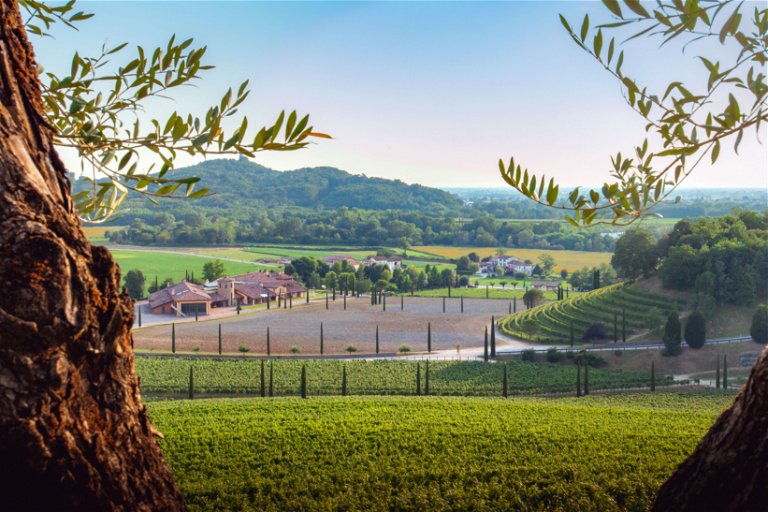Friuli: One of Italy’s Top White Wine Hotspots
Friuli – or more correctly Friuli-Venezia Giulia - is one of Italy's leading white wine regions. Besides Pinot Grigio and Sauvignon Blanc, the local varieties Ribolla Gialla and Friulano play an increasingly important role. The key wine-growing areas can be found in the east of the region: Collio, Colli Orientali and Isonzo.
There is a reason why a double-headed eagle is proudly emblazoned on the entrance gate of the Russiz Superiore winery: the area was part of the Habsburg Empire until 1918, and a dozen bloody battles were fought on the nearby Isonzo plain. Today peace has returned, but tradition lives on. You can find it reflected not only in the region’s cuisine but also in the range of grape varieties grown. Pinot Bianco (Pinot Blanc), Chardonnay and Sauvignon Blanc were introduced here – as in Styria or South Tyrol – as early as the 19th century. Until a few decades ago, Franconia (Blaufränkisch) and Riesling Italico (Welschriesling) were also to be found growing amongst the gently rolling hills.
Russiz Superiore relies heavily on Pinot Blanc, which is left to mature for long periods. The winery, like the Marco Felluga vineyard in Gradisca, belongs to the Marco Felluga family. In recent years, both wineries have been run by Roberto Felluga. After his untimely death last year, however, Roberto's daughter Illaria has taken up the reins – now the third generation to run the two traditional wineries. Patrizia Felluga also belongs to the dynasty. She broke away from the family business at the beginning of the millennium to found her small winery. Zuani - as it is called - is located near San Floriano in Collio, just on the border with Slovenia.
Patrizia Felluga started out with a radical concept: to move away from the varietal wines that dominate Friuli towards cuvées that are an expression of the area and the winery. Her two key wines, “Zuani Vigne” and “Zuani Riserva”, are both such cuvées made from Friulano, to which some Chardonnay, Pinot Grigio and Sauvignon Blanc are added. “Zuani Vigne” is aged only in stainless steel, “Zuani Riserva« in French oak. Over the years, this founding ideology has softened somewhat, and there are now also two varietal wines in her stable: a Pinot Grigio and a Ribolla Gialla. “The market demanded it,” says Patrizia Felluga. And as long as the quality is as good as her Pinot Grigio Sodevo, nobody is complaining.

The original innovator
Silvio Jermann has relied on cuvées for his top wines from the very beginning too. He created his “Vintage Tunina” for the first time in 1975. And the “recipe” of the Tunina has been carefully maintained down the years: half international varieties (Chardonnay and Sauvignon Blanc), the other half local varieties (Ribolla Gialla and Malvasia). “Vintage Tunina” is by far the most awarded white wine in Italy and formed the basis for Jermann's success. The second of his top wines, “Dreams”, is an elegant, even grandiose Chardonnay.
The triumvirate of Jermann's finest wines is completed by the single-site “Capo Martino”, which consists mainly of Pinot Bianco. Around the turn of the millennium, Jermann was the talk of the town and a regular on quality wine lists, but in recent years this exceptional wine estate has fallen somewhat quiet. After all hopes of succession within the family had dwindled, the winery, which had grown to an impressive 160 hectares in Friuli and another ten in Brda, Slovenia, was taken over by Marchesi Antinori last year. Thankfully, Antinori’s focus is squarely on continuity, guaranteed not least by Silvio Jermann himself, who will continue to be on hand to offer his expertise.

The hills to the north
The Colli Orientali del Friuli - COF for short - stretches north of Collio to Nimis and Ramandolo, never straying far from the border with Slovenia. Most of the wine producers here are traditional family businesses. Adriano Gigante is one of them. His speciality is Friulano, a local variety called »Tocai Friulano« until 2008. Friulano yields powerful wines with emphatically spicy notes. Gigante's flagship is the Friulano Storico, whose grapes come from vines over 50 years old, their trunks thick and gnarled with age. “Storico & Friends” is the name of Gigante's top wine, in which he combines Friulano with Chardonnay and Malvasia. Dense, expressive red wines meanwhile are Paolo Rodaro's domain. Under the name “Romain”, he brings some wonderful, matured red wines to the market.
His grand passion is for the Refosco grape. This local variety produces robust wines with grippy tannins and pronounced acidity. Skilful ageing in wooden barrels gives Rodaro's Refosco a certain finesse, however without losing its wild character. Rodaro not only leaves his red wines to mature for extended periods, selected batches of his white wine also receive the same treatment. He learnt about the quality of mature white wines from the legendary South Tyrolean cellar master Sebastian Stocker, Rodaro recalls with a smile. Under the name “Evoluto”, he brings this approach to his top wine, the “Curie Climat”, which comes from a selection of the best Chardonnay grapes from the Vie-di-Romans vineyard.
